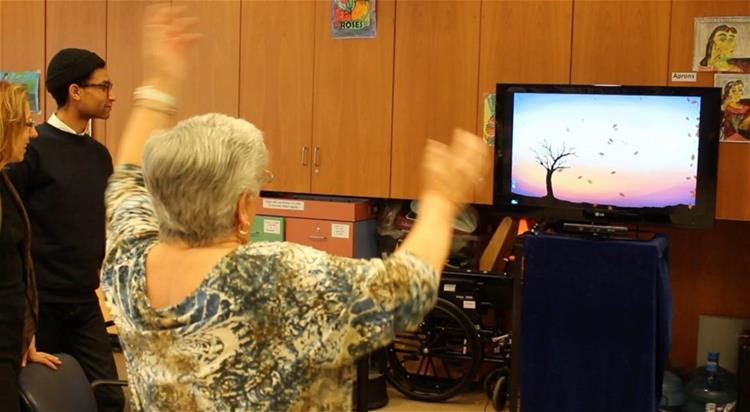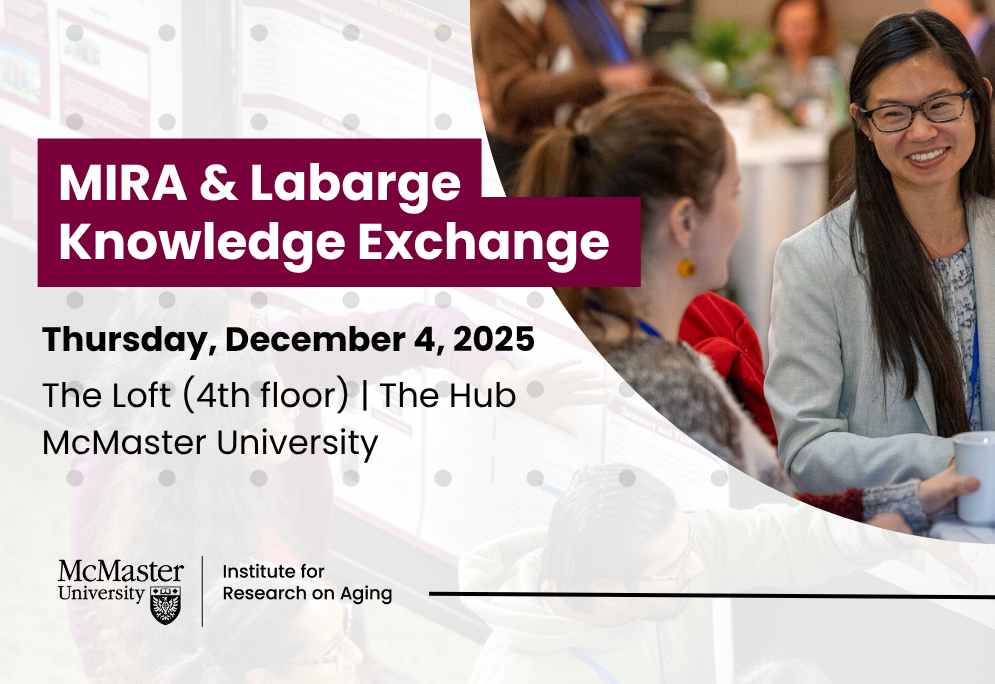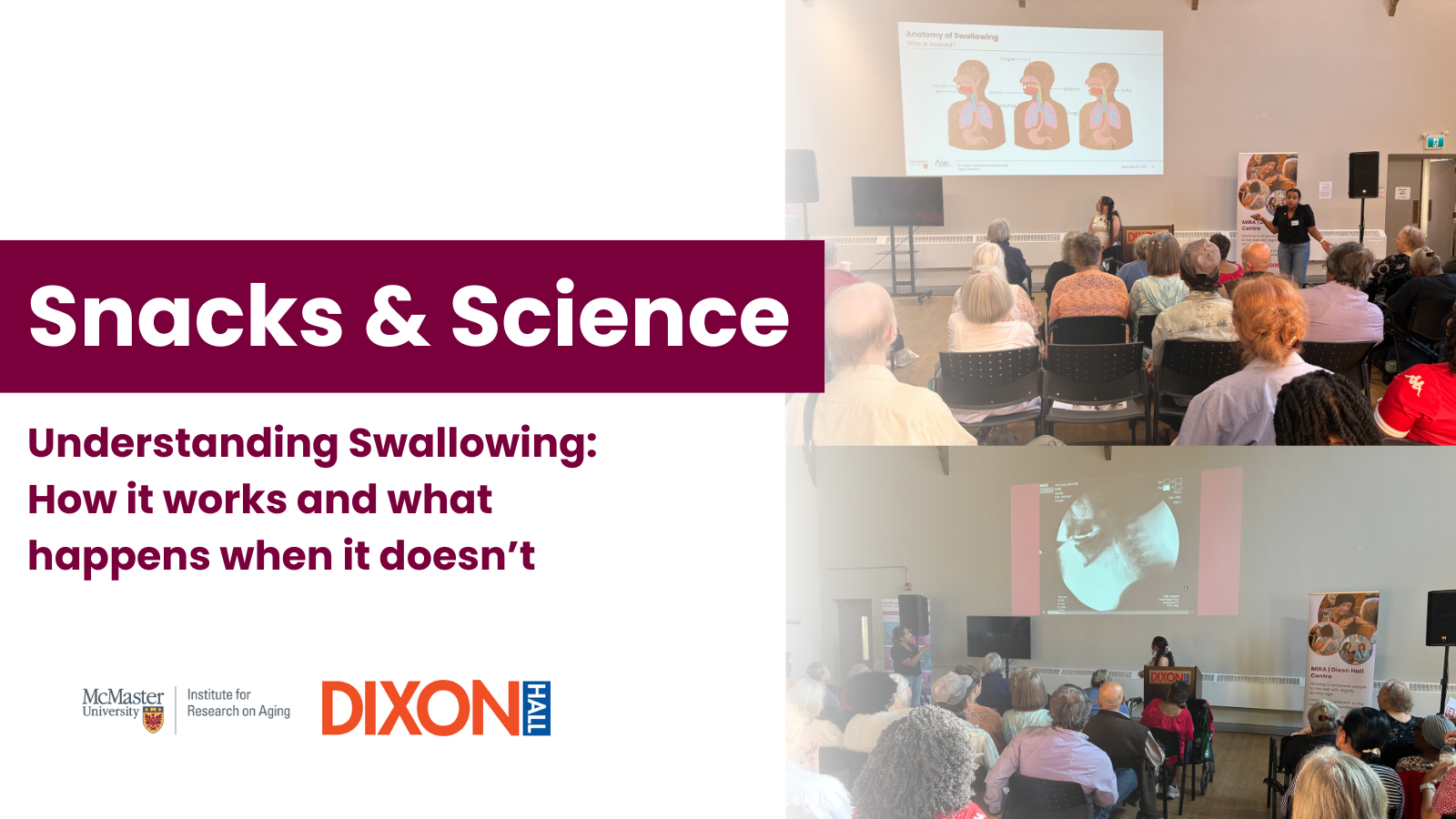
Stephen Surlin (left), Adekunle Akinyemi (centre) and Caitlin McArthur test out the ABLE device. Photo by JD Howell.
Published: October 25, 2019
There’s a medical aspect – the diseases that affect people as they age, and how to best manage the process of aging from a health-care perspective.
There are social factors, too – how does society enable its aging members to live as well as possible, for as long as possible? What supports are in place, and how do older adults access consistent levels of help when it’s needed?
There’s technology – advances in high-tech devices and services that may provide older adults with more independence and mobility in the not-too-distant future.
And then, of course, there are the humans involved – the person who is aging, as well as their families, social circle, caregivers and society at large.
Which means that if you’re going to do research on aging, you’re facing complex questions from a lot of different perspectives.
That’s why the ABLE project (Arts Based Therapies Enabling Longevity for Geriatric Outpatients) includes researchers from health care, computer science, engineering, and communication and multimedia, ranging from undergrads to full professors.
ABLE is a digital platform that older adults or their caregivers can use for either rehabilitation exercises or free-flowing dance movement. People who use ABLE can create a piece of music, paint a digital picture or play a game by waving their hands, dancing or making similar movements. It’s similar to Xbox Kinect or Ninetendo Wii games, except that the result is arts-based, rather than a hole-in-one or knocking all the bowling pins down.
ABLE is also a lot more than just technology, explains the project’s lead investigator and Asper Chair in Communications, Paula Gardner.
“We’re also trying to understand the relationship between aesthetic or art practice and movement, and what types of art engagements might incentivize older adults to engage in movement or mobility,” she explains.
“Some research suggests that, neurologically or affectively, something happens when you engage in visual or multi-sensorial experiences – that it triggers desire and interest and allows you to engage more freely and intuitively.”
You need a little of everything
ABLE started with the support of a Catalyst Grant from the McMaster Institute for Research on Aging (MIRA), which fosters interdisciplinary collaboration.
“MIRA’s innovative platform is what inspired this, because they require you to work across three faculties,” Gardner says. “We would have done that anyway, because to make this work, you need the communications and arts-based design practices, you need the computer science and engineering, and you the need the health and medical sciences as well.”
Gardner, an associate professor of communication studies and multimedia, is joined by colleagues Alexandra Papaioannou, a geriatrician and the director of the Geriatric Education and Research in Aging Sciences (GERAS) Centre and Rong Zheng, a professor of computing and software in the Faculty of Engineering.
They are joined by a large team of postdoctoral and PhD candidates, as well as master’s and undergrad students. This includes postdoctoral candidate and physiotherapist Caitlin McArthur, who has helped develop physical therapy exercises that mesh nicely with the platform as well as protocols for testing the device in home environments.
They’ve also hired an app developer, bringing aboard engineering master’s student Adekunle Akinyemi, who specializes in design thinking. From the computer and software engineering department, Jason Xiaodong Xu, a master’s student, and PhD candidate Julie Yujiao Hao, work with Zheng.
PhD candidate Stephen Surlin, who works with Gardner and has been with ABLE since its inception, concentrates on the hardware and software design as well as user interaction aspects of the project.
Lost in translation
Everyone on the team agrees that interdisciplinary research is key to these kinds of multi-faceted projects – and everyone also agrees it isn’t easy working across so many subject areas. Different fields have different ways of collecting, using and expressing data, so things may get lost in translation – literally.
“Something as simple as the word protocol can be confusing – we have a completely different meaning for the word in computer science,” laughs Zheng. “Even what counts towards publication is different – there’s certainly value in simply coming up with a procedure, and we tend to downplay that in engineering.”
But even more challenging is finding funding.
For example, it’s been tough to get the major federal research funding agencies – NSERC, CIHR and SSHRC – to recognize the team’s interdisciplinary work. SSHRC grants don’t cover health-care research, the CIHR has something for AI-driven health research but not much else, and CIHR has an interdisciplinary body but no real opportunities for a project like ABLE.
“Our search for grants has demonstrated the challenges for interdisciplinary work – we keep going to each other’s areas, but there’s not a whole lot of interdisciplinary health research being funded,” Gardner says. “We haven’t been able to target the standard tri-council grants, so we’re looking at other organizations.”
That means funding from McMaster has been key – and is helping ABLE provide a valuable training ground for future researchers.
“MIRA funding planted the seed, and then we looked at the opportunity,” Papaioannou says.
“To foster collaboration requires an investment. Other universities may do that among investigators, but to have a whole table of students and trainees at different levels is fairly unique.”
Recently the team has had success in winning funding from the Alzheimer Society and a SPARK grant from the Centre for Aging and Brain Health Research (CABHI) to fund the design of ABLE targeted to the needs of older adults with cognitive impairment.
Shaped by older adults
Regardless of its challenges, the project continues to grow and evolve, taking feedback from the platform’s users to continuously improve it.
“We’re interested in how older adults define mobility,” explains Gardner. “Instead of us coming in and saying, ‘This is what you need to achieve,’ we’re asking what they’re looking to accomplish.”
The platform has been tested in multiple focus groups at St. Peter’s Hospital in Hamilton, and the team is working on developing ways to bring a multigenerational aspect to its use – all with the ultimate goal of improving older adults’ mobility, cognitive skills and overall quality of life.
“The platform can resolve a number of problems: it encourages sociality and family bonding, which is one of the major problems that contributes to exacerbating frailty and mood disorders,” Gardner says. “The synergistic effect that we see is between movement, art practice and physiological and cognitive enhancements all together.”
This article was first published by the ​Brighter World. Read the original article here.

